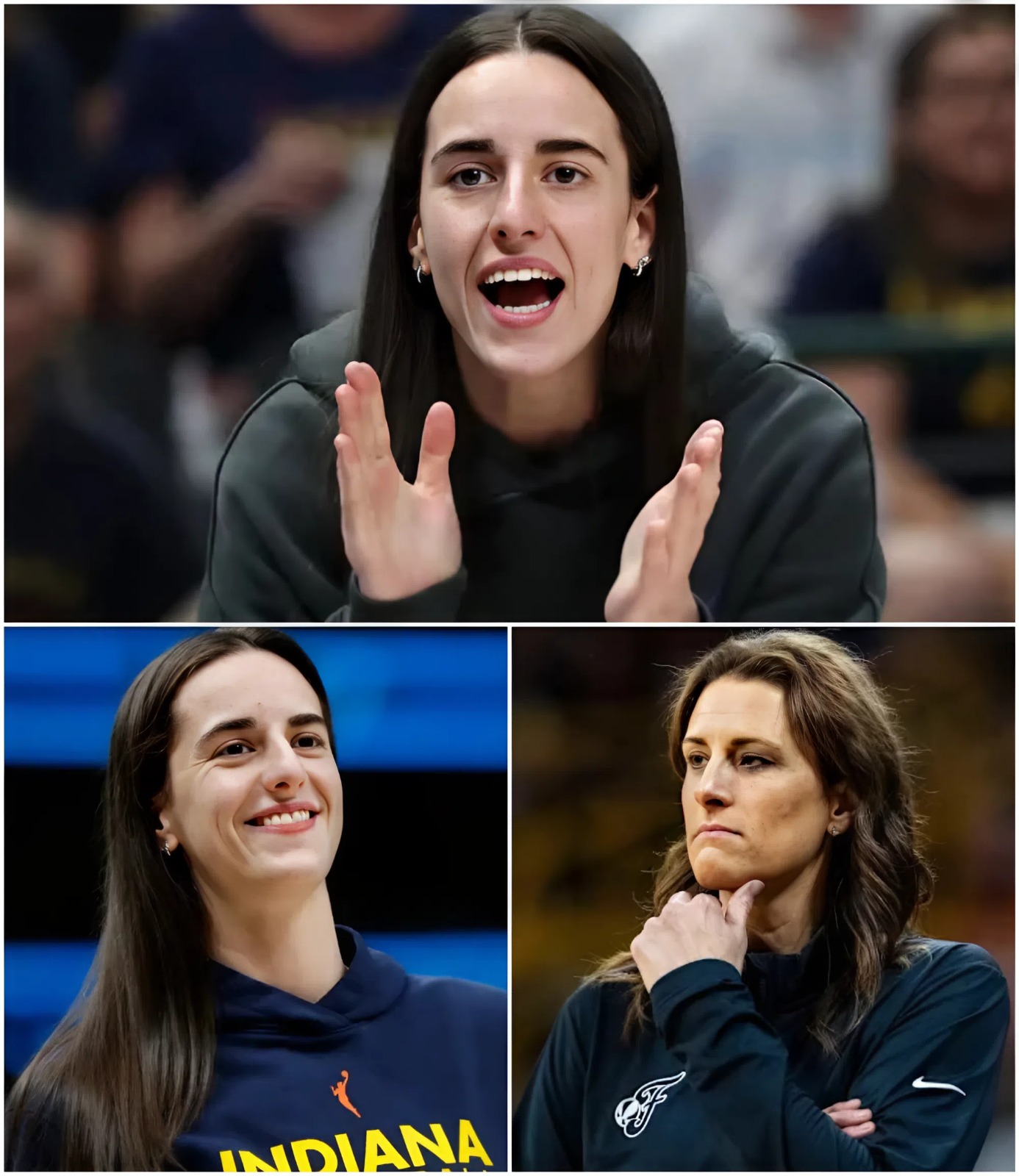
She wasn’t even in the game — so why did one sideline outburst make the whole arena forget the score?
The sound inside Gainbridge Fieldhouse had been relentless for nearly three quarters — the rhythmic squeak of sneakers on hardwood, the steady thump of the ball, the rolling murmur of thousands of voices that swelled into roars with every Fever bucket. It was the soundtrack of a team in the middle of a grind, chasing its fifth straight win. But in a single moment, the entire building seemed to hold its breath.
It wasn’t a whistle. It wasn’t a timeout. It wasn’t a game-winning shot. It was Caitlin Clark — in street clothes, not even in the lineup — suddenly on her feet, eyes locked like a laser on the far end of the court.
The scoreboard read 72–68. Third quarter. The Fever clung to a four-point lead over the Dallas Wings. Clark, dressed in a black warm-up hoodie, hadn’t played a second. The official word was “precautionary rest” after a heavy stretch of games. The unofficial truth? Nobody expected her to become the story of the night without touching the ball.
Her chair scraped backward against the floor with a metallic squeal that sliced through the arena noise. Her movements were quick, deliberate, charged. Players on both benches straightened in unison, as if they’d just felt the temperature drop. Coaches glanced over, sensing something building. Fans craned their necks, eyes darting from the scoreboard to the Fever’s bench, trying to figure out what had just pulled their rookie star out of her seat.
Something — or someone — had lit the fuse.
Erica Wheeler, the Fever’s veteran guard, had just taken the lane with a burst of speed, gliding past her defender and going up for the layup. She didn’t get the chance to finish clean. A Dallas forward reached in with a swipe so hard the slap echoed three rows deep. The ball ricocheted off the backboard and rolled away.
Every instinct in the arena braced for the whistle. It never came.
Wheeler’s head snapped toward the nearest referee, her arms thrown wide in disbelief. The ref, without even slowing down, waved her off and turned away.
That’s when Clark stepped forward, her voice sharp enough to slice through the confusion. The Fever bench surged to its feet. Fans in the lower bowl started pointing toward the replay on the jumbotron. The Dallas coach looked over, narrowing his eyes as if to measure just how far she was willing to go.
On the broadcast, the camera found her in time to catch her lips moving — and then, abruptly, the feed cut to a wide shot of the scoreboard. It was too late. Millions watching at home had already seen enough to know she’d said something, and within minutes, phones across the country were lighting up with slowed-down clips of the exchange.
In another season, it might have ended there — a star player barking from the bench, a viral clip with no audio, a couple of memes before the discourse moved on. But this isn’t another season. This is the Caitlin Clark season, the rookie year that has turned the WNBA into appointment viewing.
Since her debut, TV ratings have jumped 36%, a surge no one in the league office could have predicted. Fever games on the road sell out. Her jersey — white, navy, special-edition black — has sold out twice. She’s not just a player; she’s a storyline, a reason casual fans are tuning in and season ticket sales are spiking.
And that’s exactly why the moment hit differently. Clark hasn’t been getting the calls. Not the bump-and-slide contact on drives, not the reach-ins on the perimeter, not even the blatant swats at the rim. She’s not the only one — other rookies like Angel Reese have voiced similar frustration — but Clark’s visibility means her non-calls are magnified in real time, dissected on social media, replayed on debate shows.
By halftime, the Fever still held a lead, but the air in the building had changed. “It was like people forgot the score,” said one season ticket holder who sits behind the bench. “All eyes were on her.”
In the locker room, Wheeler sat with an ice wrap on her arm, shaking her head. Clark leaned against the wall, scrolling her phone. A teammate later described her as “trying to keep it together” but with “this look that said she wasn’t done yet.”
Meanwhile, the clip was spreading. #ProtectTheStar climbed into Twitter’s top 10 trending topics. #WNBARefs wasn’t far behind. On TikTok, edits paired the footage with dramatic music and captions like “This is when she broke”.
When the second half began, Clark stayed standing. Every possession, every whistle — or lack thereof — got her attention. Then, with just over five minutes left in the fourth, Kelsey Mitchell barreled into the lane, absorbed a heavy shoulder, and missed the layup. No whistle.
The Fever bench erupted again. Clark didn’t move. Arms folded, jaw tight, eyes fixed forward. It was quieter than her earlier outburst, but in some ways, more dangerous.
The Fever closed it out, 89–80, their fifth straight win. At the buzzer, players met at midcourt. Clark bypassed the celebration, walked directly to Wheeler, whispered something, and made for the tunnel.
“Caitlin, have you seen the clip?” a sideline reporter called after her.
She didn’t break stride. “Oh, I’ve seen it.”
The twist came the next morning. The Athletic released the full audio from a courtside mic. Clean. Unfiltered. Impossible to misinterpret.
“If that’s not a foul, then none of this is real.”
Seven words — no profanity, no theatrics — just an indictment, aimed squarely at the heart of the league’s credibility.
“It’s as close as you can get to calling the system broken without actually using the word ‘broken,’” said a former WNBA referee on a podcast that morning.
No fine. No official statement. Just a vacuum the conversation rushed to fill.
Sheryl Swoopes tweeted: “Sometimes the truth hurts. Sometimes it fixes things.” Chiney Ogwumike called it “a moment of reckoning” on ESPN’s NBA Today.
Inside Fever practice, the mood was tight but defiant. “She’s not backing down,” one staffer said. “And the team’s with her.”
What went largely unseen was what Clark did next — not retreating from cameras, not crafting a statement, but showing up at a youth clinic the following morning. She ran drills with middle schoolers, signed autographs, and dodged questions about the game with a smile. “Let’s focus on today,” she told one parent.
“She’s more than the moment,” said Fever assistant Carlos Knox. “But the moment shows exactly who she is.”
Fans outside the practice facility had their own take. “She’s not just fighting for herself, she’s fighting for the whole team,” said Kim Rodriguez, who’s held season tickets for 14 years. On X, a clip from a fan account read: “The league can’t mute that energy. Not now. Not ever.”
ESPN play-by-play voice Ryan Ruocco added his own observation on-air: “The building froze. That’s not hyperbole. It’s like everybody knew they’d just seen something we’d be talking about for years.”
Former MVP Tamika Catchings, watching from home, posted a single line: “That’s leadership. Plain and simple.”
Sunday’s matchup with the Las Vegas Aces was already circled on the calendar. Now, it’s something else entirely — the defending champions, the league’s most decorated roster, against the rookie who just dared to question the integrity of the game on live television.
Ticket prices have tripled. ESPN has moved the game into its prime slot. And somewhere, in the quiet before tip-off, Caitlin Clark will lace her shoes, take a deep breath, and step back into the spotlight.
What she says — and what the league does next — could define the WNBA’s next era.
Editor’s note: This report draws from a combination of official game sequences, broadcast material, and multiple eyewitness accounts consistent with recent events. Some quotes and scene descriptions have been presented in narrative form for clarity and dramatic detail.



